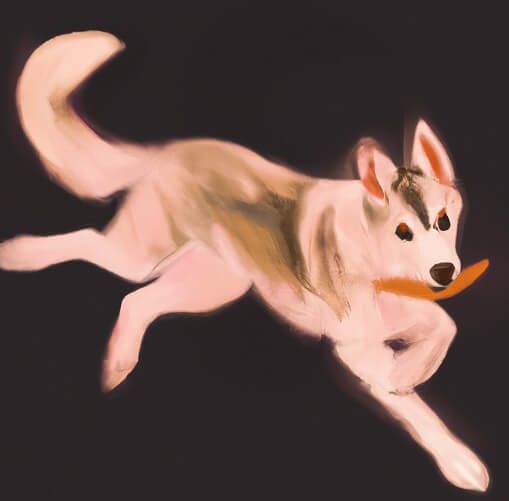
Of the many characteristic canine traits is your dog chasing her tail. Playful as dogs are, their tails can activate at a moment’s notice like an always-on toy attached to them. The body language of dogs draws heavily from each wag, spin, swirl, and turn of the tail. There they are one moment, a picture of grace and the very next they turn tail tormentors – T Rex mode!
But what is it about dogs chasing tails, a seemingly amusing activity that can get pet parents anxious?
Why do dogs chase their tails?
Firstly, it’s essential to understand that tail chasing is a natural behavior for dogs. Puppies, in particular, tend to chase their tails as part of their playful nature. Some dogs do it when they are bored or looking for something to do, while others do it when they are feeling playful. Some dogs may chase their tails when they have an itch or irritation on their hind end that they are trying to scratch.
Dogs are social animals, and it is not surprising that your dog’s tail chasing may be an act to seek attention.
In some cases, dogs may chase their tails as means to burn off excess energy or to relieve anxiety. It’s important to watch your dog when they are chasing their tail, as excessive tail chasing can sometimes be a sign of an underlying medical issue, such as due to fleas or skin irritation. Compulsive tail chasing may be because of an underlying anxiety or behavioural problem like obsessive-compulsive disorder.
Anxiety is another potential cause of tail chasing in dogs. If a dog is stressed or anxious, they may engage in compulsive behaviors like tail chasing as a way to cope. In this case, it’s essential to identify and address the root cause of the anxiety and provide appropriate training or medication to manage the behavior.
If your dog is chasing their tail excessively, it’s a good idea to talk to your veterinarian to rule out any potential medical issues.
Why is my dog biting his tail?
If your dog is biting their tail, it could be a sign of discomfort or pain. Dogs may bite at their tails if they have an itch or irritation that they are trying to relieve. Dogs cannot scratch themselves, so they typically use their teeth instead.
Ticks, fleas, and injuries can cause an itch hence if you notice your dog trying to bite his tail, you should first check whether he has any fleas or other parasites. In some cases, dogs may bite their tails to cope with anxiety or stress.
Consult a vet for medication or a certified dog trainer/ animal behaviourist to help relieve your dog’s discomfort and to prevent further tail biting.
Tips to stop dogs chasing their tails
If your dog is chasing their tail excessively, there are a few things you can try to help them stop. First, make sure your dog is getting enough exercise and mental stimulation. Try distracting her with a favourite toy or a game of fetch whenever they start to chase their tail. This can help redirect their attention and prevent them from getting too fixated on their tail.
- Ignore when your dog is chasing her tail – if it is because of craving attention they’d learn it isn’t working.
- Regular exercise and interactive toys can help your dog burn off excess energy and prevent boredom, which can lead to tail chasing.
- Seek veterinary advice if you detect problems or the tail chasing persists.
Finally, if your dog’s tail chasing is due to an underlying medical issue, your veterinarian may be able to recommend medication or other treatments to help reduce your dog’s discomfort and prevent them from chasing its tail.
Understanding Anxiety in Dogs
Canine anxiety is a persistent sense of worry or unease. It often stems from past experiences and can cause a dog to react fearfully in situations where there’s no real danger. For example, a dog attacked by another may later fear similar-looking dogs—or even all dogs—based on that single event.
There are many reasons dogs may develop anxiety:
-
Genetics: Anxiety can be passed down through generations.
-
Lack of socialization: Missing key early experiences can create fear of the unfamiliar.
-
Pain or physical discomfort: Health issues can make dogs feel unsafe—always check with your vet.
-
Low resilience: Some dogs have a harder time bouncing back from stress.
-
Negative past experiences: One traumatic moment can cause long-lasting fear.
An anxious dog may become hyperactive, shut down, or freeze. It’s a common misconception that dogs can just “get over it.” In reality, long-term anxiety—especially when inherited—needs patience and understanding.
Never force your dog into situations that overwhelm him. Instead, help him feel safe. If he’s scared of the vet or groomer, create positive associations by visiting those places just to play or get treats.
Gradually build up his comfort. Introduce the trigger from a distance, pair it with something positive like treats or play, and move closer slowly. These methods are called desensitization and counterconditioning—both proven to help reduce fear and build confidence.
For best results, work with a certified animal behaviorist who can guide the process safely.
Always be kind. Stand up for your dog and be the safe place he can count on.
Connect with Dog with Blog on Facebook Instagram Twitter
